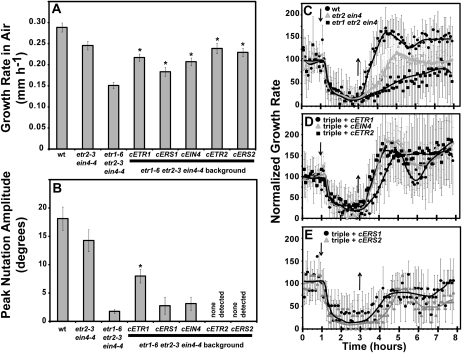Figure 3.
Rescue of growth, nutations, and growth recovery by various ethylene receptor isoforms. Triple etr1-6 etr2-3 ein4-4 mutants were transformed with cDNA for ETR1, ERS1, ETR2, EIN4, and ERS2. All constructs were under the promoter control of ETR1. For comparison, data from Col (wt), etr2-4 ein4-4 double mutant, and etr1-6 etr2-3 ein4-4 triple mutant seedlings are shown. A, The growth rates in air of triple mutants transformed with the indicated receptor isoform are shown. Basal growth rate in air was determined from the first hour of growth kinetic measurements prior to the introduction of ethylene. Data represents the average growth rate in air ± sem. B, Nutations in response to 1 μL L−1 ethylene were measured in etr1-6 etr2-3 ein4-4 triple mutants transformed with the indicated receptor isoform and amplitudes calculated as described in the “Materials and Methods.” The average peak nutation amplitude ± sem is plotted. In A and B data were analyzed with t tests and increases over the etr1-6 etr2-3 ein4-4 triple mutants were considered statistically significant for P < 0.05 (*). C, Growth kinetic profiles for wt, etr2-3 ein4-4 double mutants, and etr1-6 etr2-3 ein4-4 triple mutants are plotted. D to E, Growth kinetic profiles for triple mutants transformed with the indicated receptor isoform are plotted. For C to E, seedlings were allowed to grow for 1 h in air, followed by the addition of 1 μL L−1 ethylene (down arrow). Two hours later ethylene was removed (up arrow) and seedlings grown in air for an additional 5 h. Growth rates were normalized to the growth rate during the air pretreatment and represents the average ± sd for at least four seedlings total in at least three separate experiments. Lines were fitted by hand.

